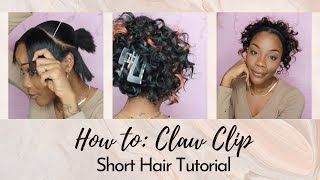Diy Hair Towel Turban Tutorial
- Posted on 07 September, 2018
- Short Hair
- By Anonymous
Step by step tutorial to make a hair towel turban. You can get a free download of the pattern plus written instructions (with pictures) at https://www.clobbercreations.co.uk/pro...
You can find me at:
Website: http://www.clobbercreations.co.uk/
Instagram: https://www.instagram.com/clobbercreat...
Twitter: https://twitter.com/clobbercreation
Tumblr: https://clobbercreations.tumblr.com/
Facebook: https://www.facebook.com/clobbercreati...
DeviantArt: https://www.deviantart.com/clobber-cre...
Music from Free Music Archive:
Six Umbrellas - Runner
Six Umbrellas - Space Disco
Wake - Glytch Funk
Broke For Free - Nothing Like Captain Crunch
You can find them all here: http://freemusicarchive.org/
Thanks for watching!
Hello, it's Chloe from Kluber creations. Today, I'm going to show you how to make a hair towel turban. So in front of me, I've got the printed pattern, so I've turned this into a PDF pattern. It'S based off the past and I made when I made one for my nan for Christmas, and I thought other people might want to have a go at it. So there's an introduction page just advising you how to print it out, as with other PDF patterns, you've got to make sure it's on a hundred percent or actual size and there's also on page 2, which is on part of the pattern. There is a test square. So you can just print out page to check the scaling is correct and it measures up to ten centimeters or four inches, and then you can go ahead and print the rest. I'Ve always they've got the fabric I need so I'm actually using her bath sheets. I find it quite hard to source toweling fabric and it's quite expensive, so for this project, I've just got a bath sheet from Ikea and it's roughly a hundred centimeters by a hundred and fifty. But for this project you only need about I'd, say about 3/4 of a meter. You should be able to squeeze one out fat. If you do you manage to find some suitable fabric in a store, I will say, got an offcut of elastic here. So this is the quarter inch, but I'd probably go for a slightly thinner than thicker elastic just because you want to be able to loop it around your button, okay, and which brings me on to that. You need a button as well, and then I've got my matching threads and a bobbin to go with it right. So, first things: first, I'm going to construct the pdf person where's, my guillotine. Have you seen it anywhere? We put it in the box. I remember that. So I've left quite a large margin on my PDF patterns, just so that it definitely prints on different sized paper. So it should work for us and UK sized paper. What I normally do is I leave the first sheet and don't bother cutting off anything on that. One and then on the next one I cut the left-hand side and then, when I get to the next row, I do the left-hand side and the top as you don't need to cut off all the edges, and this should help you line it up. Okay, so now that I've cut out my template, I just thought: I'd highlight a few points on the pattern, so I've marked four notches on this pattern. Two of them have labels the other two, don't the two that don't they're around the long curve. These ones are just simply to help you line up the T pieces before you save them up the other two I've got one at the bottom and one at the top there's one which is labeled button placement markers. So that's just to help give you a guide of where to place your button at the end, but obviously you can adjust that and I've also got one at the top, and this one is an elastic placement marker. So that's where you're going to add your elastic. So it's it's worth adding those marks onto your fabric, but yes, so now I'm going to cut out my fabric right. So I'm not sure you can see on the camera that on my fabric, I've actually used the stripy section on it. So with this, and it's quite handy to find out where you know to to get it lined up nice and evenly and but obviously there is also a grain line printers on there to help you so once you've cut out to your fabrics features it's time. To add the elastic so for this you need to grab one of the pieces and you need to have it right side out, so I'm just going to take the bottom layer as that one's right side up already. So the first thing you need to do, if you haven't done already, is to cut your piece of elastic to eight centimeters long right. So you need to fold your elastic piece in half like so, and then you need to get it to meet with the raw edges on your favorite piece that you're putting on the bright side and you're, placing it where your marker is, and I'm just going to Add a pin to position that for now so for this, I've just use the sewing machine to tuck it in place, but you could just dump and stitch as well. Now we've got this bit of elastic types in place. I'M now going to place the other person piece on top of it and now I'm going to pin - or in my case I'll, probably use some clothing clips and then I'm going to stitch all the way around this long curve back edge, which will form the back Of the hair towel turban, if you do have an overlocker what you could do, instead, when you cut it out, you could tough the seam allowance. So I've put half an inch on this, which is one point two centimeters, but you could reduce that and just use your overlocker and go around the edge. Otherwise you could leave it how it is and allow your a blocker to trim it off. So if you do have an overlocker, you could just over look at the stage if you don't and you will need to go on to the sewing machine stitch through and then you'll need to neaten the raw edges after. Alternatively, if you do have an overlocker still by all means, you can, as it's quite a curved edge you're. More than welcome to just use your sewing machine to stitch the original seam allowance to start with, and then you could overlook the ends after which is what I'm going to do in this case. One thing to know if you are overlooking and you're going to trim these seam allowances is to just make your markings for the buttonhole a bit clearer. This will just help for aligning because you may end up dropping off the bit way you did market. So I'm just going to extend lying down a bit so that I can see it after I've ever locked once you've neatened off these things, I would recommend giving that theme a little bit of a press just so it lies a bit flatter. So my overlooking I've. Just overlooked the two layers together, but I'm just going to ensure that it it presses to one side before I neaten those front these front raw edges. There'S a next step. You need to finish off the front raw edges before you neaten up the seam, so I'm going to use an overlocker because I have one if you don't have one, if you just use a zig-zag stitch just to prevent a bit of fraying and that's what you Need to do next now that you've neatened up the raw edges. You will need to press under a half inch seam allowance for 1.2 centimeters all of the way around and then you'll need to stitch that fairly close to the raw edge, but just be careful of where your elastic is hanging out pending how thick elastic you use. It might go lower down than you expect. You might just want to adjust where you're stitching liners okay, so your hair turban is almost complete. Their final step is adding the button to this end, so you should still have a marker if you transferred it a bit higher up. So I'm going to use that to roughly gauge where I want to put the button. I'Ve actually changed my mind on buttons. While I've been making this, they have now decided to use a slightly bigger button now for the button, you want to make sure it's tied on really secure just because it's going to be holding back that bit of elastic, which might be quite taut, so just bear That in mind, so I've doubled my neighbor and tied a knot. So we stay handy to give it a little bit of wiggle room as well. So I'm just going to find something I can put in the back. Okay, so far walking foot gage, I'm just going to use the round bet. Okay. So now you have your button in place. Hello again. So here is the final hair towel turban. So I just give you a quick whirl around, so you can see it from different angles. So, from the back, you can see that I've got the button down there as I've got quite a big head. It might be better if I'd positioned it slightly up, so that would be my main recommendation, although I have put where the button could be placed on the pattern, I'd recommend you know trial and error, seeing you know whoever you're making it for if you're making it For yourself, if you've got a smaller head, it's probably fine lower down there, but if you've got a bigger head like myself, you might want it a little bit higher up and you could also extend the elastic a bit, although that will wear out in time. So it will become a bit looser and more flexible. So this then bit of elastic I've got. There is quite tight, but if you use something like hat elastic, it will probably be a bit have a bit more give than this one. So, although I do feel the button could be a bit higher up for me, I think when the elastic and wears in a bit, it won't be a problem for me anymore. So I'm quite happy with the fit - and I have put this on with dry hair. So it was a bit challenging to put on, but if you've got wetter hair, I'm sure it'd be a lot easier to put your hair turban on and another thing to note is I've got quite long hair. So what I do when I put a towel turban on, is I just fold the excess in. So if you go hair, that's longer than the length of this and that's what I'd recommend doing? Okay, that's all I've really got to say on it. So yeah. If you do want to make this yourself, just don't click on the link below and you should be able to download the PDF that I've created for this thanks for watching bye,





Comments
S R: 6:00 Awesome music!